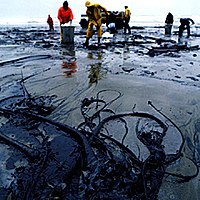
Photo from wikipedia
Abstract Thermal remote sensing has been used in assessing oil spills in the ocean, mostly based on empirical interpretations. This study designs a ground-based experiment to measure brightness temperatures (BTs)… Click to show full abstract
Abstract Thermal remote sensing has been used in assessing oil spills in the ocean, mostly based on empirical interpretations. This study designs a ground-based experiment to measure brightness temperatures (BTs) of oil-in-water (OW) emulsions with different concentrations and oil-free water as a function of time in 32 consecutive hours. Compared with a previous thermal experiment to measure oil slicks (i.e., non-emulsified oil) with different thicknesses and considering the similarity between oil slicks and water-in-oil (WO) emulsions, it is found that (1) the diurnal response of brightness temperature difference (BTD, between oil samples and oil-free sample) to oil emulsion types (OW or WO) is similar, making it difficult to classify oil emulsion types using thermal remote sensing; (2) in contrast, BTD under thermal balance during the optimal time window appears to be a function of equivalent oil thickness (EOT) (oil volume per area, mm) regardless of oil emulsion type, suggesting that EOT could be estimated from BTD. Application of such experimental results to Landsat imagery over the Deepwater Horizon oil spill in the Gulf of Mexico suggests that although their ability to quantify oil footprint is limited, thermal data show potentials in providing unique information (e.g., estimating EOTs for up to 4 mm without the need of differentiating sub-pixel heterogeneity) to complement optical data in characterizing oil type and oil quantity when the spilled oil is thick (> 0.4 mm).
Journal Title: Remote Sensing of Environment
Year Published: 2021
Link to full text (if available)
Share on Social Media: Sign Up to like & get
recommendations!